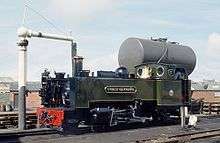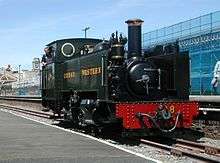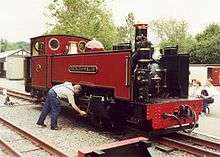Locomotives of the Vale of Rheidol Railway




The Vale of Rheidol Railway, which runs from Aberystwyth to Devil's Bridge (Wales), opened in 1902, and was later operated by the Cambrian Railways, Great Western Railway and British Rail before being 'privatised' in 1989 and run as a heritage railway operation (though arguably it had operated as a tourist ailway operation since the mid-1930s, when the GWR withdrew freight services and winter passenger services, rendering the railway wholly reliant on the tourist trade). It is built to 1 ft 11 3⁄4 in (603 mm) gauge.
Locomotive Details
No 1, & No 2 (later 1212 & 1213)
The VoR commenced operations with two 2-6-2T locomotives constructed by Davies & Metcalfe of Manchester, Nos.1 and 2. These locomotives were given Nos.1212 and 1213 by the GWR when it took over the line on grouping. They were Davies and Metcalfe's first locomotives and a Great Central Railway boilersmith, Thomas Kay, provided expertise in their construction. The contract was given to a company previously inexperienced in locomotive building (although previously they were involved in the repair of locomotives and made injectors) because Mr. Metcalfe was an Aberystwyth man. The design draws inspiration from the Manning Wardle 2-6-2Ts on the then-newly opened Lynton and Barnstaple Railway, to which they bear some resemblance. This may be because the Szlumper family was heavily involved in both railways' design and construction.
No 3 (later 1198)
No. 3 was a small 2-4-0T locomotive, originally built by Bagnall of Stafford for a Brazilian cane plantation in 1896 but never delivered as the order was cancelled, Bagnall regauging the locomotive from 750 mm (2 ft 5 1⁄2 in) to 2 ft 3 in (686 mm) when it was sold to the Plynlimon and Hafan Tramway and named Talybont. In 1903, after the failure of the Plynlimon and Hafan, it was purchased by the VoR, regauged to 1 ft 11 3⁄4 in (603 mm) and renamed Rheidol. The GWR numbered it 1198 in 1923, but it was withdrawn and scrapped the following year, having never carried its GWR number.
No 4
In 1902 the railway's Directors temporarily hired a locomotive from the Ffestiniog Railway. The engine sent was Ffestiniog No 4 'Palmerston'. The following year VoR engine No 3 'Rheidol' was acquired (see entry above), but a need for a fourth locomotive was still discerned. Palmerston No 4 was therefore hired again from Ffestiniog, and became the regular fourth engine for the next twenty years, being hired for several long periods, interspersed with brief home visits to Ffestiniog. The engine carried fleet number '4' in reference to its position on its home railway, although the number also matched its position on the Vale of Rheidol, as the fourth engine. When the line was acquired by the Great Western Railway, the leased locomotive was no longer required and was returned to Ffestiniog (from where it was immediately re-hired to the Welsh Highland Railway, to assist with construction). Palmerston (an 0-4-0ST+T) was built in 1864 by George England of New Cross, the fourth of the original four Ffestiniog Railway locomotives[1] and was named after the Prime Minister, Viscount Palmerston. Palmerston returned to the Vale of Rheidol in 2014, hauling a series of special trains during September to celebrate its association with the VoR, and to commemorate both a century of history since the first world war, and 25 years of VoR independent operation.[2]
No 7, No 8, & No 9 (& re-use of '1213')
Shortly after taking control of the line, the GWR overhauled No 1212 (No 1) and under the pretence of a 'heavy rebuild' actually built an entirely new 1213, the original (No 2) presumably being scrapped. At the same time, two new locomotives (numbered 7 and 8) were built to the same design as the new No 1213 at the GWR's Swindon Works. In 1946, the GWR undertook a renumbering of the remaining locomotives inherited from pre-Grouping companies, and this saw the 'new' 1213 being renumbered as No 9. The original No 1 (No 1212) had been withdrawn in the 1930s and after a while scrapped, as it was found that three engines (7, 8, & 9) could quite easily cope with day-to-day operation of the railway.
It is still possible to find references (in print, and on-line) to the mistaken belief that No 9 is one of the original Davies & Metcalfe Locomotives,[3] as some websites and books incorrectly perpetuate this myth,[4] having been successfully hoodwinked by the coverup at Swindon Works.[5] The Works were very effective in their coverup, entitling the parts that made up the new No 1213 as 'spares' in the accounts book, as the GWR Board had only given them leave to build two new locomotives (No 7 & No 8).[6] A simple test to prove that No 9 is actually of the same vintage as No 7 & No 8 is to compare the working drawings between it and a Davies and Metcalfe locomotive — Rheidol historian C C Green, who carried out this comparison, stated of all three current locomotives that "mechanically they are identical", and having compared the current No 9 (the 'new' 1213) with the plans of the original 1213 stated that "no single part" of the original locomotive could possibly have fitted the new one.[7]
Along with other ex-GWR locomotives, No 7, No 8, & No 9 all retained their numbers under British Railways ownership, and in 1956 were given the names which they still carry today, being unnamed up to that point. These three locos were the only steam engines to survive in BR's ownership after the end of mainline steam traction in August 1968, excluding steam powered cranes which remained in service until 1995. Under the TOPS numbering arrangements introduced at this time they were allocated Class 98 and were nominally numbered 98007–98009, but these numbers were never actually carried on the locomotives. All three locomotives, and the rolling stock, carried standard British Rail 'rail blue' livery until the 1980s, when the locomotives were given more traditional liveries that they had carried in the past. The rail blue livery has now gone, but these three locomotives remain in use on the VoR today, now back in private hands through the ownership of the Phyllis Rampton Trust.
No 10
The steam locomotive fleet is today supplemented by a single diesel locomotive, number 10, built by Baguley-Drewry and brought to the railway by the Brecon Mountain Railway during the time when the VoR was owned by the same company. Although it lacks the power of the steam locomotives, it is available for shunting duties, works trains, and also operating light passenger trains.
Additional Motive Power
In the past
For 30 years from the early 1950s until 1985 a powered Wickham trolley operated on the line, as a permanent way engineers' vehicle, and for track inspection.
In the present
A 'Permaquip' vehicle was added to the fleet in 1985 to replace the aging Wickham Trolley. This light locomotive carries out track inspections, and has an extended cab allowing it to convey a team of permanent way engineers or other staff in comfort, and protected from the elements.
Summary of locomotives
The table below lists all those locomotives owned by the VoR, leased to the VoR, or built to its designs:
| Locomotive | Built | Scrapped | 'Old' VoR No. | GWR No. (1923) | GWR No. (1946) | TOPS No. (1968) | Current No. | Name | Notes |
|---|---|---|---|---|---|---|---|---|---|
| Former Locomotives | |||||||||
| 1 | 1902 | 1932 | 1 | 1212 | - | - | - | Edward VII | Withdrawn 1932. (Name removed 1923) |
| 2 | 1902 | 1924 | 2 | 1213 † | - | - | - | Prince of Wales | Withdrawn 1924. |
| 3 | 1896 | 1924 | 3 | 1198 | - | - | - | Rheidol | Withdrawn 1924. |
| 4 | 1864 | - | 4 | - | - | - | 4 | Palmerston | Hired from the Ffestiniog Railway in the summer seasons of 1902, 1912, 1913, 1914, 1915, 1921 and 1922. The locomotive still operates on the Ffestiniog Railway.[8] The locomotive was hired again in 2014 with Palmerston hauling a series of special trains in September 2014.[9] |
| Current Locomotives | |||||||||
| 7 | 1923 | - | - | 7 | 7 | 98007 | 7 | Owain Glyndŵr | Undergoing overhaul. Name applied by BR. |
| 8 | 1923 | - | - | 8 | 8 | 98008 | 8 | Llywelyn | Name applied by BR. |
| 9 | 1924 | - | - | 1213 † | 9 | 98009 | 9 | Prince of Wales | Name applied by BR in the mistaken belief that they were restoring the original name. |
| 10 | 1987 | - | - | - | - | - | 10 | - | Modern diesel locomotive. |
† These were two entirely different locomotives. The same number was transferred from one to the other as an accounting exercise.
Gallery
-

No. 9 at Swindon works in 1954.
-

No 8 Llywelyn at Devil's Bridge - at this time all three steam locomotives were allocated a TOPS code, and painted in rail blue livery.
Notes
- ↑ See entry at this location for details.
- ↑ See Palmerston page of VoR website.
- ↑ See, for example, Michael Rutherford, 'Railway Reflections No 129', photo caption of Nos 8 and 'new' 1213, the latter referenced as 'formerly No 2': photo captions indexed at SteamIndex, here.
- ↑ See, for example, the incorrect locomotive data catalogued here by the Narrow Gauge Railway Museum website.
- ↑ See 'Vale of Rheidol Light Railway', by W J K Davies, published 1964 by Ian Allen Limited, for a discussion of the accounting coverup.
- ↑ See British Heritage Railways website, section headed 'locomotives'.
- ↑ 'The Vale of Rheidol Light Railway', by C C Green, published in 1986 by Wild Swan Publishing, ISBN 0-906867-43-6.
- ↑ Quine, Dan (2013). The George England locomotives of the Ffestiniog Railway. London: Flexiscale.
- ↑ See Palmerston page of VoR website.
